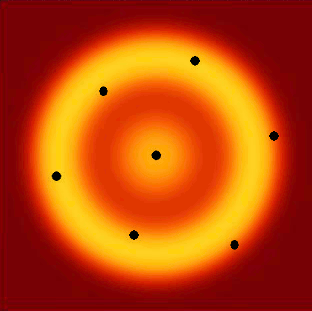 | ||
The Strictly-Correlated-Electrons (SCE) density functional theory (SCE DFT) approach, originally proposed by Michael Seidl [1], is a formulation of density functional theory, alternative to the widely used Kohn-Sham DFT, especially aimed at the study of strongly-correlated systems. The essential difference between the two approaches is the choice of the auxiliary system (having the same density
Contents
Calculation of the co-motion functions and interaction energy of the SCE system
For a given density
The co-motion functions can be obtained from the integration of this equation. An analytical solution exists for 1D systems [2,3], but not for the general case.
The interaction energy of the SCE system for a given density
Notice that this is analogous to the Kohn-Sham approach, where the non-interacting kinetic energy is expressed in terms of the Kohn-Sham single-particle orbitals.
A very important property of the SCE system is the following one: since the position of one particle determines the position of the remaining ones, the total coulomb repulsion felt by a particle at a point
At the same time, it can be shown that the potential
A promising route towards the application of the SCE approach to systems with general symmetry is the mass-transportation-theory reformulation of the approach [8]. This is based on the analogies between the SCE problem and the dual Kantorovich problem [8]. The SCE wave function is also very useful to set rigorous bounds for the constant appearing in the Lieb-Oxford inequality.
Combining the strictly-correlated-electron and the Kohn-Sham approaches
The one-body potential
which relates the Hartree-exchange-correlation (Hxc) functional and the corresponding potential.
The approximation (which becomes exact in the limit of infinitely strong interaction [5]) corresponds to writing the Hohenberg-Kohn functional as
where
One has therefore
which can be solved self-consistently.
Since the
